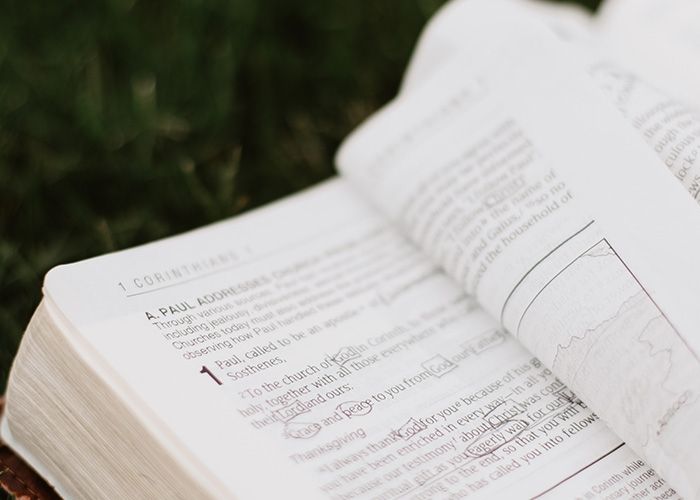Many people are interested in reading the Bible, but don't know where to start. Maybe you read the article, "How the Bible Can Become Your Most Well Loved Book," and picked just the right edition. You selected a Bible for your purpose—devotional reading, studying, bringing to a Bible study. You picked the right size, durability, maybe even a nice color. Then you flipped through some pages, only to realize that the Bible is a big book. It can be intimidating to open and jump in.
How can you navigate the Bible, making it more than just another book on your shelf? How can you pick it up, start reading, and create lasting habits? Try these 6 steps, or if you are a seasoned Scripture reader forward to a friend who is just getting started.
1. Table of Contents
It sounds simple, but don't overlook the table of contents. It will help you map out what is in the following pages. Take a moment to read through the names. Do you recognize any of them? Are any new? Try saying some out loud. Look some up. What books come earlier and later? Start getting familiar with the books in the Bible and how to find them.
2. Look Up a Verse
Whether you are reading large portions of Scripture or shorter sections, you will need to know how to look up Bible references. Chapters and verses were not included in the original manuscripts, but they help us navigate the Bible today. Each reference includes the book title, chapter, and verse. Try looking up "Psalm 119:105." Find the page number for Psalms in the table of contents, then go to chapter 119 and scroll down to verse 105. What does the psalmist say about the law of the Lord?
3. What's in the Bible?
You will notice that the books of the Bible are divided into two sections, the Old and New Testaments. The Old Testament includes the Law, History, Poetry and Wisdom, and Prophets. The New Testament includes the Gospels, the History of the early church, Epistles (letters), and Prophecy. These books span a variety of literary genres, time periods, and historical contexts. Read a short introduction to each book as you go. This will frame your reading, bringing more depth and helping you understand the book's purpose and intent.
4. Don't Start at the Beginning
Unlike other books, you don't have to start at the beginning. Genesis gives a beautiful creation account, but you may get tripped up with questions you aren't yet ready to wrestle with. Why are there multiple accounts of the same story? How do I make sense of creation in light of modern science? Is this a historical account? Rather than getting stuck, many people find it easier to start in the New Testament, with the Gospels. The Gospels are more narrative-driven, and they introduce you to the life, death, and resurrection of Jesus. Jesus's teachings are richly instructive, his life endlessly fascinating, and the story will give you a strong foundation for reading other books of the Bible.
5. Pick a Reading Plan
Try following a reading plan to guide your daily reading. You can create your own—perhaps reading several chapters of Luke every day, accompanied by a Psalm. You can download an app, I have found YouVersion's Bible reading app particularly helpful. Or subscribe to a Scripture email, like American Bible Society's Daily Bible Reading. You may consider reading the Book of Common Prayer or Church Lectionary. Reading plans connect you to a whole community of Bible readers! Others are reading the same passages each day. Together we are contemplating God's Word and being united as the universal Church.
6. Ask for a Hunger and Thirst
What is the best way to form a lasting Bible reading habit? Jesus says, "Blessed are those who hunger and thirst for righteousness, for they will be filled" (Matthew 5:6 NRSV). Ask God to give you a hunger and thirst for reading Scripture. Join me in this prayer:
God, let me hunger and thirst for your truth in Scripture. Let me encounter you through reading the Bible. Give me a desire and longing for your Word, so that I will crave the words that sustain me. Let me seek you and trust you. Let these words be my health and healing (Proverbs 3:1-8). Guide me, teach me, abide with me. Amen.
Want to start reading the Bible?
Read more posts about: Reading the Bible, Perspective
Thanks to the support of our faithful financial partners, American Bible Society has been engaging people with the life-changing message of God’s Word for more than 200 years.
Help us share God's Word where
needed most.
Sign up to receive Bible-reading tips, tools and resources.




